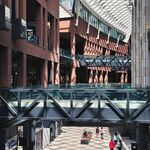Gahh... I had wrote a longer reply but my browser crashed, so this will be more condensed.
Re. Train capacity, I think your numbers are off. A TR can hold 183 ppl, and the TTC acknowledges that's a conservative estimate.
You can always crush more people in. But you don't design to crush loads. Yes, 183 for 23-metre subway car sounds about right ...
it's actually 180 if you check the current TTC peak loading standard. However a T1 is slightly lower at 167, because you don't have people standing in the extra space where the cab and between the cars. With a 20-metre single-car train, you should be comparing to a T1, not a TR. And then, you are talking 20 metres, not the current 23 metre car. So take 167, divide by 23, multiply by 20, and you get about 145.
At that level, peak demand on the ECLRT would take about 29 trains.
If peak is 5,000 it would only take 28 with your 180 person car. It takes 30 with a 167 person car.
Designing a line to avoid capacity constraints in the year 2100 is silly; any savings which would be had then would have a NPV today of 0$.
2100? 5,000 is forecast for 2031, only 11 years after the line opens. You break that in 2032 ... you might not design for 80 years in the future ... but you do design for more than 20!
As for alternatives, I'd written a more detailed answer, but I'll just leave the TTC's capacity chart here.
So what do you propose? A partially exclusive right-of-way wasn't considered an option on Eglinton between Keele and Laird because of the width. So you either are stuck with a 2,000 capacity for mixed right-of-way ... or you tunnel. How do you save anything? They've gone for partially exclusive right-of-way for the sections of Eglinton with a wider right-of-way.
So how do you save anything? They've done the minimum east of Laird, and had to resort to a tunnel to the west, because of the narrow road.
According to that chart, at 8,000 even the non-exclusive right-of-way east of Laird doesn't work!







